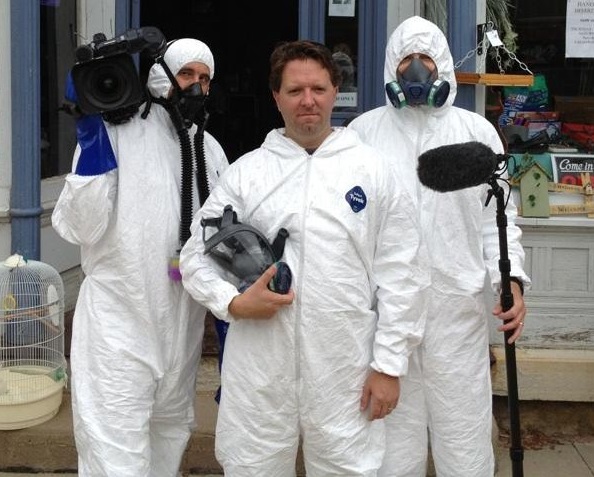Matt Paxton describes himself as the guy from the television show Hoarders that cleans up the messiest homes in America.He’s even spent nights sleeping in hoarded homes with bugs, rodents and other unmentionables.Why? So he could truly understand the people he was trying to help. In many of these cases, there are mental health issues at play.But many of us have trouble getting rid of things. It seems to be in our nature, and Paxton says it’s easy to get overwhelmed. He told 680 CJOB he has two rules he tries to express to people:1. Equal In, Equal Out: If you buy a new shirt, for example, another one has to go out. If you bring in something new, something of the same size needs to go. Paxton says you have to be firm with this rule. Otherwise, your house will fill up.
2. 10 Minute Sweep: Spend ten minutes every day cleaning. No more, no less. That way, your home will stay somewhat clean. He believes a home should be lived in, but not dirty.Paxton said he sees first-hand all the time how difficult and emotional it can be to let go of things.“We want to feel good about ourselves, so we say, ‘Oh, I need a bigger car, I need nicer boots, I need nicer pants, I need this, I need that.’ We attribute our success not to the hard work, but to the items that we buy with that hard work,” he said.Paxton said there’s another reason that we hang onto things: they are old items that remind us of people we’ve lost.“It’s pretty simple, the stuff is just a trophy. We all have way too much stuff. But the old stuff reminds us of past lives and the new stuff gives us hope for future lives.”It’s hard enough to let our own stuff go. But what do you do when others add to what you already have? Perhaps your parents are aging or have passed away, and you’re now stuck with another houseful of things, all attached with memories. Paxton is blunt.“When the items are passed to the next generation, they become the items of that generation and they can do whatever they want with them.”He knows that can be easier said than done. His own mom has kept his grandmother’s items because she felt bad.“The guilt is so real… (But) I believe guilt is a choice, you don’t have to feel guilty. And the reality is, your parents are dead, so what are they going to care?”
2. 10 Minute Sweep: Spend ten minutes every day cleaning. No more, no less. That way, your home will stay somewhat clean. He believes a home should be lived in, but not dirty.Paxton said he sees first-hand all the time how difficult and emotional it can be to let go of things.“We want to feel good about ourselves, so we say, ‘Oh, I need a bigger car, I need nicer boots, I need nicer pants, I need this, I need that.’ We attribute our success not to the hard work, but to the items that we buy with that hard work,” he said.Paxton said there’s another reason that we hang onto things: they are old items that remind us of people we’ve lost.“It’s pretty simple, the stuff is just a trophy. We all have way too much stuff. But the old stuff reminds us of past lives and the new stuff gives us hope for future lives.”It’s hard enough to let our own stuff go. But what do you do when others add to what you already have? Perhaps your parents are aging or have passed away, and you’re now stuck with another houseful of things, all attached with memories. Paxton is blunt.“When the items are passed to the next generation, they become the items of that generation and they can do whatever they want with them.”He knows that can be easier said than done. His own mom has kept his grandmother’s items because she felt bad.“The guilt is so real… (But) I believe guilt is a choice, you don’t have to feel guilty. And the reality is, your parents are dead, so what are they going to care?”

Paxton doesn’t plan to continue storing his family’s stuff.“You know what I’m gonna do with 99 per cent of it when my mom goes? I’m going to toss it in the trash, and I ain’t going to feel bad about it, at all. I focus on my current family.” he said.The one per cent he will keep? A few items like pictures and jewelry.It can be trickier with mothers-in-law.“Both partners need to be able to say to the mother and the mother-in-law, ‘Hey, we’re good, our house is full.’”He suggests you re-direct that stuff elsewhere, either by selling the item or donating it.But what about all your children’s special school projects and art work? Those can become sentimental favourites.Paxton revealed he has 15 pieces of ‘mediocre’ art coming into his house every week, and he’s sure none of his kids will become famous artists. So he and his wife take a picture of the project and out it goes.“We keep one a month, and at the end of the year we put two or three of them into a box.”So how does Paxton want to assure you that less is more? Again, he draws on personal experience.“My dad died 17 years ago. That’s how I got into this business. I had to clean up my dad’s house. I really miss my dad. But the reality is, 17 years later, my kids barely even know my father’s name. I’ve got to focus my life on my three kids and creating memories for them.”He suggests keeping things like board games, for example, as they create memories.“I try to say keep the items that help you move forward as a family, and not the ones that hold you back.”





Comments